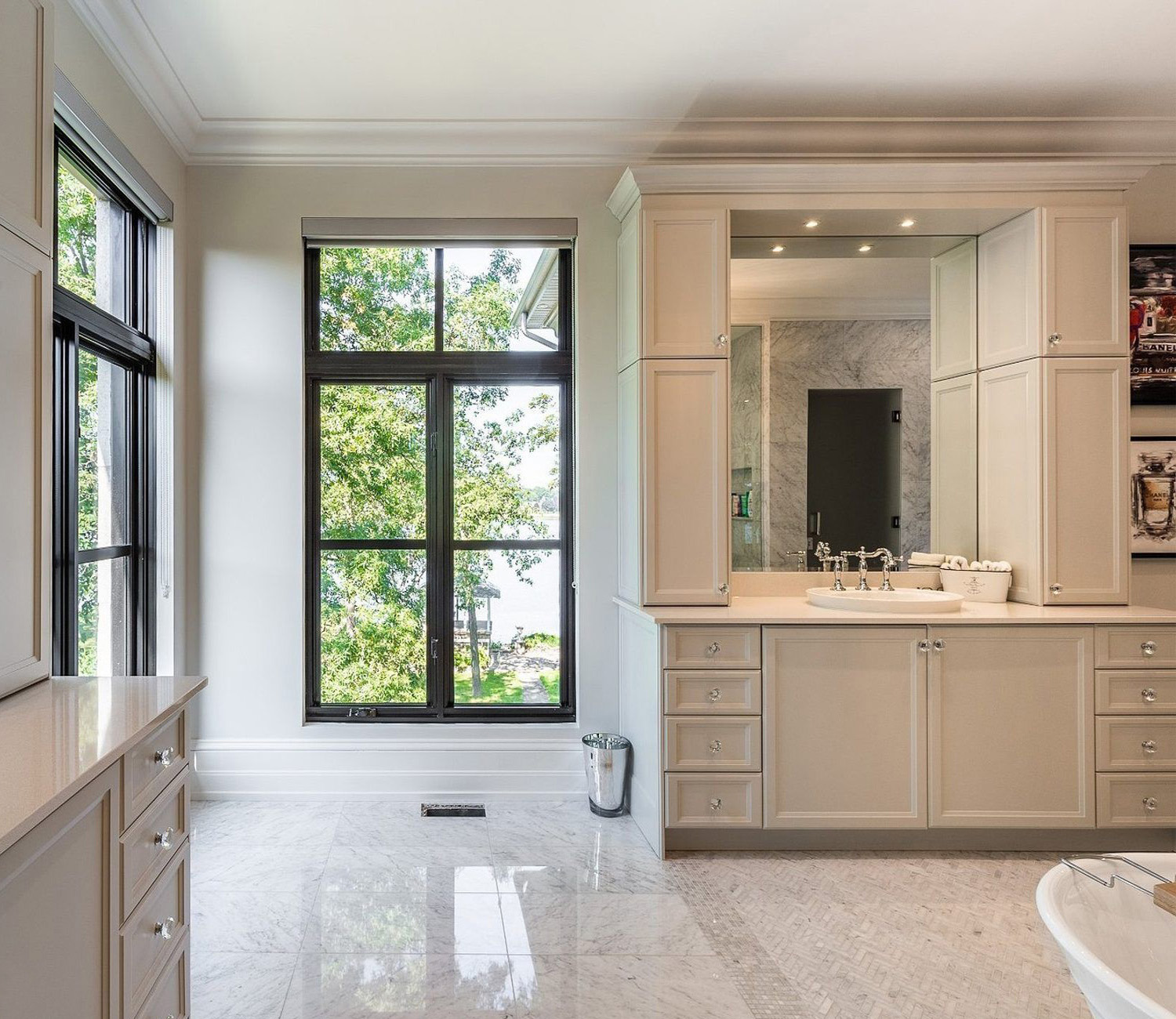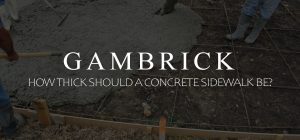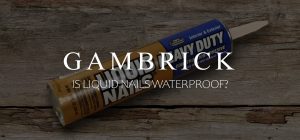How Thick Should Thinset Be For Tile?
Most tile installations require a 3/16 inch thicker layer of thinset beneath the tile. This create a strong and stable bed which prevents cracking and popped tiles. Its done using a 3/8 inch square notch trowel. Running the trowel along the floor creates 3/8″ x 3/8″ square lines and grooves of mortar. When the tile is pressed onto the floor it compresses down to a 3/16 inch thick mortar bed. This thickness is ideal for most floor tile, but not all.
For heavy tile you need a thicker layer of thinset. Because of gravity, heavy tiles depresses harder which squeezes some of the mortar out of the sides. If the thinset is too thin tiles could eventually pop up or crack. For heavy tiles use a 1/8 inch thick layer of thinset. This is achieved with a 1/4 inch square notch trowel. When the tile is depressed onto the mortar it creates a 1/8 inch thick bed.
Thinset is typically used to lay floor tiles, not wall tiles. It’s a cement based material that cures with high compressive strength. If you apply a thick enough layer of thinset beneath the tile they should not pop up or crack. But the floor has to be stable enough for tile. For best results, install some cement backer board or a membrane like Schluter on top of the floor sheathing before you start spreading thinset.
Make sure to use a square notch trowel when applying thinset for floor tiles. V-notch trowels are primarily used for wall tiles. If you use a v-notch trowel for a floor, the thinset will be too thin which could cause cracked or popped tiles.
Always use at least a 3/16″ to 1/8″ layer of thinset beneath the tiles.
What Is The Minimum Thickness For Thinset?
The minimum thickness for laying tile with thinset is 3/6 inch. This is achieved using a 3/8 inch square notch trowel after the tiles are pressed in to the mortar.
Thinset is a cement based mortar designed to be strong and adhere well in a thin layer usually no greater than 3/16 inch. But for heavy tiles I usually use a 1/4 inch square notch trowel which produces a 1/8 inch thick bed when the tile is depressed.
The thickness of your thinset is dictated by the type of trowel you use and its size. Thinset for floor tile is applied using a square notch trowel, not a v-notch.
If you use a standard square notch trowel with evenly spaced notches, the resulting thinset layer will be one-half the tooth depth. This means that a 3/8 X 3/8” square notch trowel spreads thinset in grooves 3/8-inch high x 3/8-inch wide with a 3/8 inch void between them. When a tile is pressed into the thinset, it spreads to fill the voids between the grooves. This results in a thinset layer 3/16ths of an inch thick.
- A square-notched trowel with even tooth spacing creates a thinset layer that is one-half the tooth depth.
- A 3/8″ x 3/8” square notch trowel creates a 3/16” thick layer of thinset. The standard size.
- A 1/4″ x 1/4” square notch trowel creates a thinset layer 1/8″ thick. Better for heavy tiles.
- U-shaped trowels leave a thinset layer one-third the tooth depth.
Remember, the thickness of the thinset for installed tiles is always less than the size of the trowel groove. These simple rules will help you calculate the thickness of your thinset for any tile job.
What Consistency Should Thinset Be?
The proper consistency of thinset is like creamy peanut butter. To achieve this, you need to use just enough water to activate all the dry ingredients but not too much or it will get watery. The correct consistency is very important when laying tile because it effects the thinset thickness and installed tile height.
- If you use too much water, the thinset will be watery which makes it ooze out when the tile is layed. This creates an uneven tile surface with low tiles and thin, weak thinset. You’ll likely end up with popped or cracked tiles and an uneven surface.
- Use too little water and the thinset will be powdery with unmixed ingredients. When you lay the tiles onto the thinset the material won’t depress like it should. The tiles will sit uneven and the bond will be weak. The result will be cracked or popped tiles and an uneven surface.
When thinset is properly mixed, it should compress 1/2 the thickness of a square notched trowel. For example, to achieve a 3/16 inch thinset thickness you use a 3/8 inch square notch trowel. When tiles are set on top the thinset, it compresses to 3/16 inch. This only happens when the thinset is properly mixed.
If the thinset doesn’t have the correct consistency, it won’t be as sticky as it should be. The result is a weak bond between the tile and sub-grade which results in cracked or popped tiles.
Thinset with the right consistency is a semi solid. It’s strong enough to support the weight of the tile but isn’t runny. It should be solid enough to stick to the trowel when you scoop it out of the bucket. But thin enough to spread with a trowel.
What Happens When You Apply Thinset Too Thick?
Applying thinset too thick can cause material to ooze out the sides when you lay the tile. The result is an uneven tile surface, a poor bond between the tile and substrate, cracked or popped tiles and ultimately a poor quality tile installation.
Thinset is a cement based products that’s designed to work in thin layers. Use just enough thinset mortar required to form a solid bond between the tile and the substrate below. In most cases, a layer of thinset 3/16″ to 1/8″ thick is sufficient.
To lay the perfect amount of thinset, use either a 3/8 inch or 1/4 inch square notch trowel.
- Too much thinset creates an uneven surface
- Thick thinset causes a weak bond between the tile and substrate. The result is popped or cracked tiles.
- The finished tile surface will be uneven and unprofessional looking.
- For most tiles, apply a layer of thinset 3/16 inch thick using a 3/8 inch square notch trowel.
- For heavy tiles, apply a layer of thinset 1/8 inch thick using a 1/4 inch square notch trowel.
- Don’t use thicker thinset in order to level a surface. Instead, level the surface first, before you start tiling.
Thinset mortar is not designed to be a surfaces leveler. Make sure you level the surface before you start tiling. Thinset is designed to form a thin layer of material that follows the contours of the surface. Using thinset to thick results in cracks, an uneven surface and poor tile adhesion.
Level an uneven surface with backer board or leveling cement before you start tiling.
Thick thinset will ruin a tile job. Make sure the surface is perfectly level before you start tiling and only apply thinset as thick as the trowel will allow. Don’t build up thinset in order to level individual tiles.
How Much Thickness Does Tile Add To A Floor?
How much installed tile raises the floor height depends on the thickness of the tile, the substrate and how much thinset you use.
Tile thickness depends on the type of tile used. Porcelain tile has typical thicknesses in the range of 1/4 to 3/4 inch thick. Ceramic tiles are usually thinner, ranging between 1/4 and 3/8 of an inch. Stone tiles like marble are usually 1/4 to 3/8 inch thick.
On top of the plywood sub-floor you should install a cement backer or membrane like Schluter. They typically add 1/2 to 3/4 inch of thickness.
Finally you have to account for the thinset thickness. Most tiles use 3/16 inch thinset applied by a 3/8 inch square notch trowel. But larger tiles can use 1/8 inch of thinset applied by a 1/4 inch square notch trowel.
If you add those measurements together you’ll find that tile typically adds around 1 to 2 inches to the floor height.
- Tile thickness depends a lot on the material its made of.
- Porcelain tiles range from 1/4” to 3/4” thick.
- Ceramic tiles range between 1/4” and 3/8” thick.
- Stone tiles range between 1/4” and 3/8” thick.
Mosaic tile used for inlays also have varying thicknesses which typically range between 1/8-inch and 1/2-inch.
When planning a tile install, take into account the thickness of your tile, the substrate and the thinset. This makes a big difference when accounting for things like base trim, door clearances and cabinet heights.
How Much Thickness Should You Allow For Thinset When Tiling?
Most thinset is applied 3/16 inch to 1/8 inch thick beneath your tile. A 3/16 inch layer of thinset is the standard thickness used for all but the heaviest tiles. This thickness creates a strong bond and an even tile surface that won’t pop or crack. For natural tiles with an uneven surface on the back or heavy tiles, use an 1/8 inch layer of thinset. The extra thickness will ooze into the uneven surface of the stone tile and better support heavy loads.
Thinset works best when it’s applied as thin as possible. When thinset is applied too thick it creates an uneven surface and a weaker bond that’s prone to cracks.
Do not spread thinset thick to fill holes or low spots. The surface should be made perfectly level before you start tiling. Then apply only as much thinset as the trowel allows.
Remember, when you use a square notch trowel the thinset will compress 1/2 the thickness of the notch. For example, a 3/8 inch square notch trowel creates a 3/16 thinset thickness once the tile is installed.
Can You Use Too Much Thinset On Tile?
Yes, you can absolutely use too much thinset on tile. The correct thickness for laying tile should be between 1/16 to 1/8 inch of thinset. This is accomplished by using either a 3/8 or 1/4 inch square notch trowel to apply the thinset. If your thinset is too thick, it will be much harder to level the tile as you install them. Excess thinset will squeeze out from under the tile which is also a problem when you grout. In addition, the bond between the tile and floor will be weaker and prone to cracked and popped tiles.
If you use too much thinset, the tile surface will likely be uneven and weak, prone to cracks and popped tiles.
- Uneven, slanted tiles are caused by using too much thinset.
- Excess thinset will ooze out from under tiles creating an uneven surface and difficulty when grouting.
- Do not apply more thinset than the trowel allows.
- Never use thinset to level an uneven floor.
If you’ve used too much thinset mortar under a tile, immediately remove the tile and all the thinset from the floor and tile. Then spread a new layer of thinset onto the floor and re-install the tile.
Never use thinset to level an uneven floor. Thinset should be applied in thin layers that mirror the contours of the floor. In order to achieve a flat and level tile job, the sub-floor must be perfectly level before you start tiling.
Does Thinset Type Effect Thickness?
Yes, there are different types of thinset mortar made from varying materials which effect its properties and thickness. Depending on which type of thinset mortar you use, the recommended thickness can vary a little.
- Dry-Set Or Unmodified Thinset Mortar: This mortar contains sand, water, water retainers, and Portland cement. Water retainers help keep the mortar hydrated as you mix it with water. Apply this mortar on the thick side around 1/8 inch thick using a 1/4 inch square notch trowel.
- Modified Thinset Mortar: Modified thinset mortars contain water retainers, sand, Portland cement, an acrylic polymer and water. The acrylic polymer improves the mortar’s adhesion which makes it work better for thinner tiles. This makes the mortar waterproof which helps in wet areas. For this mortar, the maximum thickness should be 3/16 inch applied with a 3/8 inch square notch trowel.
No matter what type of mortar you use, the recommend thickness range is always between 3/16 inch for most tiles and 1/8 for heavy or tiles or tiles with an uneven surface.
How Thick Should Thinset Be For 1/4 Inch Tile”
Thinset for 1/4 inch thick tile should be 3/16 inch thick. It should be applied using a 3/8 inch thick square notch trowel. When the tile is pressed down into the thinset, the 3/8 thickness will compress down to 3/16 of an inch which creates a strong, stable and uniform mortar bed.
Do not use too much thinset when laying tile. It’s a strong cement based mortar that mirrors the level of the floor. If your sub-floor isn’t perfectly level, don’t lay tile. Level the sub-floor using cement board or a floor leveler before you lay tiles. Once the floor is perfectly level, apply just as much thinset as the trowel will allow.
Using too much thinset will generally result in an uneven surface and a weaker bond between the tile and sub-floor.
How Thick Should Thinset Be For 12 x 12 Inch Tile”
Thinset for 12 x 12 inch tile should be 3/16 inch thick. It should be applied using a 3/8 inch thick square notch trowel. When the tile is pressed down into the thinset, the 3/8 thickness will compress down to 3/16 of an inch which creates a strong, stable and uniform mortar bed.
- 12 x 12 Inch tile is generally around 1/4 inch thick. If you’re laying a heavy tile that’s 1/2 inch thick or more, use a thinset thickness of 1/8 inch. It should be applied using a 1/4 inch square notch trowel. The extra thickness will help support the heavier load.
- If the tile has an uneven surface, use the thicker 1/4 inch thick thinset bed. Thicker thinset will help because it oozes into the back of the tile filling in small crevices and holes. You can also try applying a bit of thinset to the back of the tile before laying it into the thinset.
- Do not use too much thinset when laying tile. It’s a strong cement based mortar that mirrors the level of the floor. If your sub-floor isn’t perfectly level, don’t lay tile. Level the sub-floor using cement board or a floor leveler before you lay tiles. Once the floor is perfectly level, apply just as much thinset as the trowel will allow.
Using too much thinset will generally result in an uneven surface and a weaker bond between the tile and sub-floor.
Is Back Buttering Tile Necessary?
Back buttering is the thin spreading of thinset on the back of a tile before you lay it onto the floor. It creates a better bond between the tile and sub-grade, but it is not necessary. Laying tile directly into thinset creates a strong enough bond when you use the correct type of thinset that’s properly mixed, a sub-grade like Schluter or cement board, and apply adequate thickness for your tile.
Normally, you would spread thinset on the floor with a trowel and then depress the tile into the thinset. When you back butter, you apply thinset to the floor with a trowel as normal, but before you lay down the tile you apply a thin layer or mortar to the back. This helps create a better bond by eliminating voids. But it also adds thickness to the thinset.
When you apply thinset with asquare notch trowel, the thinset compresses to 1/2 the thickness of the trowel notch. For example, when you cover a floor with thinset using a 3/8 inch trowel, it will compress down to 3/16 when the tile is installed. Back buttering eliminates most of this compression and thickness loss because it adds thinset to the back of the tile.
There’s no doubt that back buttering a tile creates a better bond. But is it necessary? no. If you install tile correctly it’s an unnecessary step.
How Thick Can You Go With Thinset?
The thickest you should go with thinset is 1/8 inch using a 1/4 inch square notch trowel. The standard thickness is 3/16 inch applied with a 3/8 inch square notch trowel, but you can go thicker if the tiles are very heavy or have an uneven surface. Thicker thinset helps support the weight of heavy tiles and is able to ooze into a tiles cracks, dimples and holes.
Never go thicker with thinset. it’s not a leveling material. many people make the mistake of applying thick thinset to try and level an uneven floor. The result is an uneven tile surface with low and high spots and a weak bond. The tiles are more likely to pop up or crack over time.
Thinset works best when it’s applied in a thin layer. Never apply it thicker than the trowel notch will allow. If the floor is unlevel, level it before you start laying tile.
How Thick Will Thinset Be With A 3/8 Inch Trowel?
Thinset spread using a 3/8 inch square notch trowel will be 3/16 inch thick. When thinset is applied using a square notch trowel, it compresses to 1/2 the thickness of the notch after the tile is installed. In this case, 1/2 of a 3/8 inch notch becomes 3/16 inch of thinset.
How Thick Will Thinset Be With A 1/2 Inch Trowel?
Thinset spread using a 1/2 inch square notch trowel will be 1/4 inch thick. When thinset is applied using a square notch trowel, it compresses to 1/2 the thickness of the notch after the tile is installed. In this case, 1/2 of a 1/2 inch notch becomes 1/4 inch of thinset.
How Thick Will Thinset Be With A 1/4 Inch Trowel?
Thinset spread using a 1/4 inch square notch trowel will be 1/8 inch thick. When thinset is applied using a square notch trowel, it compresses to 1/2 the thickness of the notch after the tile is installed. In this case, 1/2 of a 1/4 inch notch becomes 1/8 inch of thinset.
Summary: How Thick Should Thinset Be For Tile?
Most tile installations require a 3/16 inch thicker layer of thinset beneath the tile. This create a strong and stable bed which prevents cracking and popped tiles. Its done using a 3/8 inch square notch trowel. Running the trowel along the floor creates 3/8″ x 3/8″ square lines and grooves of mortar. When the tile is pressed onto the floor it compresses down to a 3/16 inch thick mortar bed. This thickness is ideal for most floor tile, but not all.
For heavy tile you need a thicker layer of thinset. Because of gravity, heavy tiles depresses harder which squeezes some of the mortar out of the sides. If the thinset is too thin tiles could eventually pop up or crack. For heavy tiles use a 1/8 inch thick layer of thinset. This is achieved with a 1/4 inch square notch trowel. When the tile is depressed onto the mortar it creates a 1/8 inch thick bed.
Thinset is typically used to lay floor tiles, not wall tiles. It’s a cement based material that cures with high compressive strength. If you apply a thick enough layer of thinset beneath the tile they should not pop up or crack. But the floor has to be stable enough for tile. For best results, install some cement backer board or a membrane like Schluter on top of the floor sheathing before you start spreading thinset.
Make sure to use a square notch trowel when applying thinset for floor tiles. V-notch trowels are primarily used for wall tiles. If you use a v-notch trowel for a floor, the thinset will be too thin which could cause cracked or popped tiles.
If you have any questions or comments email any time.

























